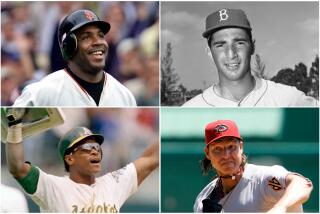For It’s One, Two, Three Strikes and You’re ‘Dead’ at Vintage Ballgame
- Share via
ELYRIA, Neb. — Uniforms are heavy and hot--thick cotton, even wool. No gloves are allowed. A bat hitting a ball is more likely to thud than crack, since the leather ball’s innards consist of yarn hand-wound around rubber.
Ah, the joys of vintage baseball. And more and more Americans are joining in.
In the tradition of Civil War reenactors, players of vintage baseball don old-time uniforms on weekend afternoons and play by the rules--very old rules.
No cursing. No stepping into the pitch when hitting. No overhand pitches. “Hurlers” throw the ball underhand to let “strikers” put the ball in play rather than try to strike them out, or “dead” in vintage terminology.
“I think as many people come out to watch the players and their antics as they do to actually see a ballgame,” said Steff Baker, founder and manager of the Ord Tigers, one of three teams in the Nebraska Vintage Baseball Assn.
Baker, decked out in the Tigers’ 1910 blue-and-white uniform of heavy cotton duck, gladly endured temperatures in the 90s one recent Saturday to get in a game at Ft. Hartsuff, an old Indian fort and now a state historic park 10 miles north of Ord in the center of Nebraska.
The Tigers are facing the historical Ft. Hartsuff Company C of the 9th Infantry, whose members are sweating in the blue woolen uniforms of 19th-century soldiers.
Standing just 45 feet from home plate, the hurler lobs an object that looks like an old brown apple, somewhat bigger than a modern baseball.
The striker hits it into the parade ground’s left field, better known as the “outer garden.” The fielder grabs the ball on the hop, and the player is “dead.” Unlike in modern baseball, one bounce doesn’t qualify as a hit.
Baseball has been played like this for some 150 years, but in the era of the modern game, such matches became novelty events. Now, vintage games are gaining popularity.
The national Vintage Baseball Assn. was formed in Columbus, Ohio, in 1996, when nine teams already playing the game decided it was time to get organized, said John Freyer, a spokesman for the national group.
“We’re finding out there’s teams playing all over the country,” said Freyer, who runs a microbrewery in Munster, Ind., and is a rover, or shortstop, with the Deep River Grinders.
The national association now has 35 member teams and knows of at least 105 teams nationwide, Freyer said.
Games and schedules are rather unstructured. The three teams in Nebraska--Ord, Ft. Hartsuff and the Railroad Town Rowdies of Grand Island--play games against each other when they can. They go to other towns when local residents can put together a team. Baker said that’s a lot like it used to be in the mid-1800s, when everybody played by different rules.
“What this town-team ball basically amounted to was every town had their own rules,” Baker said. “You had the three bases and home plate, and that’s pretty much where it stopped.”
Some vintage teams have female players, and Baker said that’s as it should be. At Ft. Hartsuff in the 1870s, the Army’s washerwomen and officers’ wives suited up so the fort could field two teams, he said. And to be historically accurate, the players of 2000 wear long dresses.
“Once we had a man and a woman going after the same fly ball, and when they collided, it was just an explosion of bloomers! An explosion of red-and-white checks --bloomers and petticoats,” Baker recounted. “What I would have given for a photograph.”
Baker, a saddle and harness maker in Ord and president of the Valley County Historical Society, makes his own equipment. He stitches the balls by hand and makes old-style bats on a wood lathe. The old bats have thicker, longer barrels than modern bats. And they’re heavier, he stressed, weighing 40 to 60 ounces, compared with the typical 30 to 33 ounces of wood or aluminum bats today.
Dale Beye, commissioner of the Nebraska Vintage Baseball Assn., and his wife, Sonja, have played with the Railroad Town Rowdies for five years. Beye and other Nebraska players hope to set up a business to sell the homemade bats and balls.
“For baseball bats, we mainly go to photographs and copy what we see,” Beye said. “I love doing that kind of stuff. I love finding something in history--and these guys are the same way--and then trying it out on the field.”
All players have nicknames, which are used liberally during games. Baker is “Stitch”; Sonja Beye is “Sassy”; her husband is “Two Bits.” Baker’s father, George, a retired veterinarian, is “Doc.”
Games in the vintage league can get competitive, but the overall goal is to have fun and relive the atmosphere of the past.
“You still have competition, but it’s not a die-if-you-don’t-win scenario,” said the Tigers’ Don “Duck” Proskocil, huffing and puffing after scoring from second base. “We have a good time.”
The Nebraska organization has hopes of staging a vintage World Series. With its central location and frontier history, Nebraska would be an ideal place, Baker said. He plans to pursue the idea after the league stops playing in mid-October.
“It’s still pretty much in the embryo stage,” Baker said. “Winter’s when we get things done. Summertime we play ball.”
More to Read
Go beyond the scoreboard
Get the latest on L.A.'s teams in the daily Sports Report newsletter.
You may occasionally receive promotional content from the Los Angeles Times.










